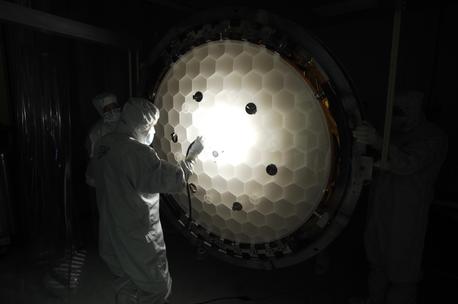New space telescope Kepler
Twelve times the light of Corot
 © NASA and Ball Aerospace
|
nspection of the primary mirror honeycomb structure. The mirror has been 86% light weighted. That is it only weighs 14% (1/7) that of a solid mirror of the same dimensions.
Solid statitical foundation
Kepler's primary mirror has a 1.4 meter diameter and will collect twelve times the light of its European counterpart, the French Corot Telescope (Convection, Rotation and planetary transits), which has been in space since 2006. Kepler is a Schmidt telescope and is especially fitting to observe a larger patch of celestial real estate. How many habitable Earth-like exoplanets found by the NASA satellite depends on their frequency of occurrence. Since that is still unknown astronomers must rely on estimates. If they exist frequently then Kepler could detect dozens. If they are rare then possibly none will be detected. In any event the space telescope will help to improve the knowledge about the allocation of exoplanets in the Milky Way. As a result the statistical model concerned with the allocation of exoplanets will be more solid, since Kepler will record the transits of all types of extrasolar planets.Diminutive amount of blocked light during transit
An Earth-like transit only blocks a diminutive amount of light from the central star in the magnitude of 84 ppm (parts per million). The transit can last for up to 13 hours. To confirm an exoplanet three similar recordings of the transit are required. Since Kepler observes the same region for 3.5 years it could, unlike Corot, recognize transits that are a year apart. This is an important observation for planets like Earth, which need a full year for a complete revolution around the central star. An exoplanet with Earth-like mass, orbiting a sun-like star in one year - that would be a small sensation. The "Second Earth" would be found.Thorsten Dambeck is a physicist and science writer in Germany. Translation: Raphael Steinbach.
New space telescope Kepler
Twelve times the light of Corot
 © NASA and Ball Aerospace
|
nspection of the primary mirror honeycomb structure. The mirror has been 86% light weighted. That is it only weighs 14% (1/7) that of a solid mirror of the same dimensions.
Solid statitical foundation
Kepler's primary mirror has a 1.4 meter diameter and will collect twelve times the light of its European counterpart, the French Corot Telescope (Convection, Rotation and planetary transits), which has been in space since 2006. Kepler is a Schmidt telescope and is especially fitting to observe a larger patch of celestial real estate. How many habitable Earth-like exoplanets found by the NASA satellite depends on their frequency of occurrence. Since that is still unknown astronomers must rely on estimates. If they exist frequently then Kepler could detect dozens. If they are rare then possibly none will be detected. In any event the space telescope will help to improve the knowledge about the allocation of exoplanets in the Milky Way. As a result the statistical model concerned with the allocation of exoplanets will be more solid, since Kepler will record the transits of all types of extrasolar planets.Diminutive amount of blocked light during transit
An Earth-like transit only blocks a diminutive amount of light from the central star in the magnitude of 84 ppm (parts per million). The transit can last for up to 13 hours. To confirm an exoplanet three similar recordings of the transit are required. Since Kepler observes the same region for 3.5 years it could, unlike Corot, recognize transits that are a year apart. This is an important observation for planets like Earth, which need a full year for a complete revolution around the central star. An exoplanet with Earth-like mass, orbiting a sun-like star in one year - that would be a small sensation. The "Second Earth" would be found.Thorsten Dambeck is a physicist and science writer in Germany. Translation: Raphael Steinbach.












